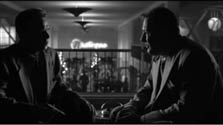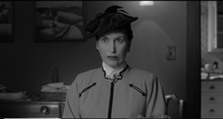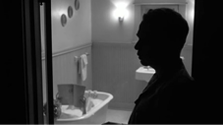doxa.comunicación | nº 31, pp. 207-238 | 223
July-December of 2020
Ana Isabel Cea Navas and Sergio García Rubio
ISSN: 1696-019X / e-ISSN: 2386-3978
aim can be seen when the main character, Ed Crane (Billy Bob Thorton), is debating whether to negotiate with a stranger he has just met; he will have to invest $10, 000 which he will try to obtain by blackmailing his wife’s lover (figure 10).
This type of backlighting will be repeated later, when Big Dave (James Gandolfini), Ed’s lover, tells Ed that he has received a bribe letter (figure 11). And it will be used again when the protagonist goes to her lover’s office (figure 12). The lack of lighting also characterises this scene. The intentionality to leave this image so dark increases the drama (a technique that coincides with the narrative: the dramatic tension is extreme and ends in murder).
At another point in the film, Roger Deakins uses a type of zone lighting: the scene in which Ed and Big Dave have a fight that culminates in the death of Big Dave takes place in one of the big warehouses with low lighting, and it focuses on some mannequins and the staircase that leads to the office where he has the altercation. The violent conflict between the two men is shown at the top and center of the image, in the background and focus, using backlighting again through which we can see the two silhouettes hitting each other (figure 13).
Deakins also uses the spotlighting technique. We can see this in the scene in which Freddy Riedenschneider (Tony Shalhoud), Fred’s wife’s lawyer, performs a monologue where he poses how he will present a defense before the jury, highlighting his backlit figure, from which a pronounced shadow is a cast (figure 14).

Source: Photo. The man who wasn’t there
Source: Photo. The man who wasn’t there
Figure 11: Backlighting of rival characters
Figure 12: Twilight in the office


Source: Photo. The man who wasn’t there
Source: Photo. The man who wasn’t there
Figure 9. Direct light Figure
10. Backlighting